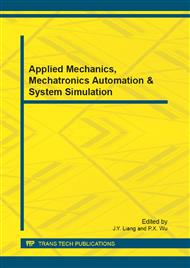[1]
H. Shi, L. Wang, T.G. Chu, Virtual Leader Approach to Coordinated Control of Multiple Mobile Agents with Asymmetric Interactions, Physica D, 2006, 213: 51-56.
DOI: 10.1016/j.physd.2005.10.012
Google Scholar
[2]
J. Liu, W. Zhong, L. Jiao, A Multiagent Evolutionary Algorithm for Combinatorial Optimization Problems, IEEE Trans. on Systems, Man, and Cybernetics, Part B, 2009, 40(1): 229-240.
DOI: 10.1109/tsmcb.2009.2025775
Google Scholar
[3]
P. Lin, and Y. M. Jia, Consensus of second-order discrete-time multi-agent systems with nonuniform time-delays and dynamically changing topologies, Automatica, vol. 45, no. 9, pp.2154-2158, (2009).
DOI: 10.1016/j.automatica.2009.05.002
Google Scholar
[4]
Re, A. Di Cintio, G. Busca et al., Novel time synchronization techniques for deep space probes, 2009 IEEE International Frequency Control Symposium Joint with the 22nd European Frequency and Time Forum. pp.205-210.
DOI: 10.1109/freq.2009.5168170
Google Scholar
[5]
R. Olfati-Saber, R.M. Murray, Consensus Protocols for Undirected Networks of Dynamic Agents with Communication Time-Delays. Technical Report CIT-CDS 03-007, California Institute of Technology, Control and Dynamical Systems, Pasadena, California, March (2003).
Google Scholar
[6]
J. Choi, S. Oh, R. Horowitz, Distributed Learning and Cooperative Control for Multi-Agent Systems, Automatica, 2009, 45: 2802-2814.
DOI: 10.1016/j.automatica.2009.09.025
Google Scholar
[7]
R. Burns, C. A. McLaughlin, J. Leitner, M. Martin, Res. Lab., and Kirtland Air Force Base, NM., TechSat 21: formation design, control, and simulation, IEEE Proc. Aerospace Conf., Montana, USA, 2000, 7: 19-25.
DOI: 10.1109/aero.2000.879271
Google Scholar
[8]
C.L. Liu, Y.P. Tian, Consensus of Multi-agent System with Diverse Communication Delays, Chinese Control Conf., 2009: 726-730.
Google Scholar
[9]
R. Olfati-Saber, R.M. Murray, Consensus Protocols for Undirected Networks of Dynamic Agents with Communication Time-Delays. Technical Report CIT-CDS 03-007, California Institute of Technology, Control and Dynamical Systems, Pasadena, California, March (2003).
Google Scholar
[10]
G.M. Xie, H.Y. Liu, L. Wang, Y.M. Jia, Consensus in Networked Multi-Agent System via Sampled Control: Switching Topology Case, American Control Conference, 2009: 4525-4530.
DOI: 10.1109/acc.2009.5160054
Google Scholar
[11]
P. Lin, and Y. M. Jia, Consensus of second-order discrete-time multi-agent systems with nonuniform time-delays and dynamically changing topologies, Automatica, vol. 45, no. 9, pp.2154-2158, (2009).
DOI: 10.1016/j.automatica.2009.05.002
Google Scholar
[12]
P Z.K. Li, Z.S. Duan, L. Huang, Leader-Follower Consensus of Multi-Agent Systems, American Control Conf., 2009: 3256-3261.
DOI: 10.1109/acc.2009.5160000
Google Scholar
[13]
R. Pereira, L. Hsu, Adaptive Formation Control Using Artificial Potentials for Euler-Lagrange Agents, Proc. of the 17th IFAC, 2008: 10788-10793.
DOI: 10.3182/20080706-5-kr-1001.01829
Google Scholar
[14]
Chen, Z.Q. Chen, Z.X. Liu, L.Y. Xiang, Z.Z. Yuan, Decentralized Formation Control of Mobile Agents: A unified Framework, Physica A, 2008, 387: 4917-4926.
DOI: 10.1016/j.physa.2008.04.018
Google Scholar
[15]
Y.G. Hong, G.R. Chen, L. Bushnell, Distributed Observers Design for Leader-Following Control of Multi-Agent Networks, Automatica, 2008, (44): 846-850.
DOI: 10.1016/j.automatica.2007.07.004
Google Scholar


